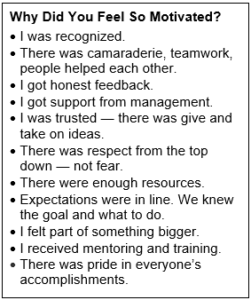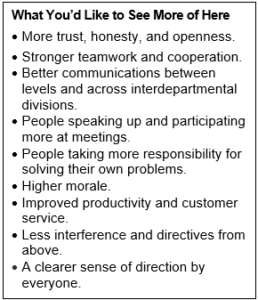
Step Two — START
Begin with your management team
Agree on the Culture You Want
Decide where you want to go, the qualities you’d like more of. This is a team decision that will take about 60 to 90 minutes.
READ MORE ![]()
Decide Where to Start
Now you know the qualities you want, discuss possible actions that might show these qualities or values in your company.
READ MORE ![]()
Begin Actions and Discuss Progress
Now it’s time for each person to choose what action they will take in their own work area. Then regroup to discuss what you each did, what happened, and next steps.
READ MORE ![]()
Agree on the Culture You Want
Before you start changing your culture, you should decide where you want to go, what kind of culture you want, the qualities you’d like more of. Here’s what to do.
With your full leadership team present, share your idea for a better workplace. Don’t say much beyond opening the discussion (definitely don’t suggest actions). When someone speaks, you just listen, no comments. Invite everyone’s thoughts.
You can show certainty and conviction. “We should do this. A great culture is good for people and good for business.” Stay open on how and what. “I’ve never done this, but we’ll work it out together as we go.” Then dive in.
“Let’s start by agreeing on the type of workplace we’d like to build, qualities we’d like more of here. Please take a few minutes and think of an actual work-related situation you have been in where you felt truly inspired and motivated about the job. It may be a business situation, or not. It may be recent or in the past, maybe even in college or school. Can you each think of a situation where you’ve had that experience, excited and motivated? Everyone? (Give time for everyone to think.) Now with that actual experience clearly in mind, write down what it was about the situation that made you feel so inspired.”
Leave plenty of time for thinking and writing. Then, go around the group asking each person for just one item. Write down what they say (including yours last) for all to see. You might find that almost everybody describes similar situations.
When no one has more to add, say, “Now look at our list and keep it in mind as you each write down what you would like to see more of here in our company.” Again, give people plenty of time to write their thoughts. Then go around the group, one item per person, and write down what they say so everybody can see. These qualities are your initial culture change goal. (Below are one team’s lists.)


Decide Where to Start
Now you’ve decided on the qualities you want, you apply them by making small changes in how you do your work, changes that show the values you’d like more of in the organization. Here’s how to move your qualities list to actions.
If you’ve run out of time at your first meeting, postpone this step until your next meeting in three weeks. Either way, explain, “We will get the culture we want by making very small changes in what we do every day, changes that illustrate or reinforce the kind of culture we all just described, what we’d like to see more of. These actions should not be anything new or unusual. They will just be small changes in each person’s daily work, nothing dramatic.
Ask each manager to write down one or two everyday activities or future actions or plans, they might use as opportunities to move the workplace culture in the direction they just described.
- For example, if an item was [we want] “more trust, honesty, and openness.”, say, “Think about what you do every day, or what is coming up in your department, that by you doing it a little bit differently, you could personally show ‘more trust, honesty, and openness.”
- If one of the items is, “Better communications between departments.” you might ask, “What do we do here, or what is coming up in your area, that by doing it a little bit differently, we or you could improve communications between departments?”
- If one of the items is, “Get people to take more responsibility for decisions that affect them.” you might ask, “What do we do here, or what’s coming up, that if we gave it a little tweak, we could get the people who are affected, more involved in decisions?”
Ask similar questions for each item from the “Qualities” list and record their answers on an “Opportunities” list. When they finish, if you see some big opportunity is missing, add it. This step is brainstorming, not a decision or commitment.
Begin Actions and Discuss Progress
Now your team has agreed on a direction and possible actions, it’s time for each person to choose what first step to take in their work area. Then get together and discuss what you each did, what happened, and next steps.
When the “Opportunities” list has at least 15 items, put it next to the “Qualities” list. Ask the group to look at the two lists. This is a good time for your team to walk around, read the lists, think about them, and share ideas. After a few minutes ask your team:
“Who’d like to put their initials against an item?” As the team leader, it’s important to put your own initials on one or two of the items, but best if you are not first.
After they put their initials against the items, ask each manager to describe what they plan to do — how they will connect the qualities to actions. Encourage your team to share ideas and suggestions with each other. Sometimes one idea will be appealing to several people. When the managers have decided what to do, describe what you plan to do and invite their suggestions. Ideally, two, three, or four people will volunteer to do something. Invite comments or suggestions from others in the group.
Conclude with, “Next time we get together, let’s discuss what we did, and what happened. Remember that we are trying to learn about the culture and what happens when we take actions to change it. What you do doesn’t have to be ‘successful’ or not, but you do have to try something. What we want to hear is what you did and what happened. After we discuss what we did, we can all decide on our next steps. We’re going to walk down this path together, step at a time, learning as we go. Okay?”
“So, What Happened?”
When you meet again in three (or four) weeks, ask each person to describe what they did and what it was like. You might find that not everybody did what they said. They might have done something different. Possibly nobody, except yourself, did anything. Sometimes everyone will have dived in. Be patient. It might take a while for everyone to see that this is serious business, important to the success of the company and that you are determined to help them make it happen.
After you and the others have described what you did and what happened, you can revisit the opportunities list, add any new items, and decide what you will each do next. “Let’s look again at the list of opportunities and see if there are any new ones we should add.” Ask people again to volunteer to do something. Have them see that you’re very serious about this. But don’t be confrontational. Just be firm. Of course, you must have done something yourself. If the leader doesn’t advance, no one else will.
A Small Warning
It’s important that this self-reflection within the leadership team develops naturally and without accusation. Culture change is not an operational problem with analysis, measurement, and corrective action. Never look backward, trying to analyze what happened, or who is at fault. That only reinforces blaming and defensiveness, qualities you do not want to encourage.
Culture change focuses on the human half of your culture, on experience, trust, relationships, and engagement. It’s your job as the leader to keep the team focused on the values you all want to reinforce, and how you each show these in your daily actions.
Successful culture change relies on deliberate, step-at-a-time leadership actions. You’ll get to know your culture by how it responds to your actions. This cannot be delegated.
